ISSN 2410-5708 / e-ISSN 2313-7215
Year 13 | No. 37 | June - September 2024
© Copyright (2024). National Autonomous University of Nicaragua, Managua.
This document is under a Creative Commons
Attribution-NonCommercial-NoDerivs 4.0 International licence.
Musculoskeletal disorders in the outpatient medical staff of the Amistad medical clinic Japan Nicaragua, Granada associated with occupational illness
https://doi.org/10.5377/rtu.v13i37.18155
Submitted on November 16th, 2023 / Accepted on May 23th, 2024
Javier Antonio Flores García
General Practitioner, Graduated with a Master's Degree in
Occupational Health. Center for Research and Health Studies.
CIES/UNAN-Managua. National Autonomous University of Nicaragua
Richard David Arana Blas
Master's Degree in Epidemiology, Research Professor at
the Center for Research and Health Studies. CIES/UNAN-
Managua. National Autonomous University of Nicaragua
Section: Health and Social Services
Scientific research article
Keywords: Symptoms, Musculoskeletal, Medical personnel.
ABSTRACT
To evaluate the musculoskeletal disorders of the outpatient medical staff of the Amistad Japan Nicaragua social security medical clinic, Granada January 2023.
Methodological design: an observational, cross-sectional, and descriptive study was carried out with 30 doctors from the outpatient clinic of the Amistad Japan Nicaragua pension medical clinic. Two instruments were used, the first consisted of an interview that allowed us to identify sociodemographic characteristics of the medical staff, as well as characteristics of musculoskeletal disorders, and the second instrument consisted of the application of the Nordic questionnaire, which is a valid instrument to determine the prevalence of musculoskeletal disorders in regions of the body, both upper extremities, thorax, and lower extremities
Result: The predominant age range was 31 to 40 years (56.7%), male sex (56.7%), work experience of 6 to 10 years (40%), job position and working hours, general practitioners work 8 hours ( 50%), medical personnel with musculoskeletal symptoms (86.7%), pain in some part of the body, shoulder (33.3%), perceived discomfort was pain (20%), the predominant musculoskeletal disorder was shoulder tendonitis (33.3% ), sex relationship and presence of musculoskeletal disorder in the female sex (100%); age and musculoskeletal disorder relationship between 31 to 40 years (56.6%); relationship between work experience and musculoskeletal disorder between 6 to 10 years. Conclusions: Musculoskeletal disorders predominate more in the female sex, it was evident that the longer the staff’s work experience between 6 to 10 years, the greater the symptoms of musculoskeletal disorders. Regarding musculoskeletal disorders, the age was between 31 to 40 years, the location of the pain was the shoulder, and it was found that musculoskeletal disorders are frequent in outpatient medical personnel, affecting the majority with shoulder tendonitis.
INTRODUCTION
Musculoskeletal disorders are a reality in almost most workers in the health sector; in fact, this type of problem in occupational health is represented by more than 150 disorders that affect the locomotor system, with the most affected areas being the back, neck, shoulders, upper and lower extremities. Low back pain is the most common, with a prevalence of 568 million people worldwide. Some of the causes that contribute to musculoskeletal disorders include workload, fractures, osteoarthritis, trauma, and amputations. Disability associated with musculoskeletal disorders has been on the rise and is expected to continue to increase in the coming decades (WHO, 2021).
Musculoskeletal disorders are physical injuries that occur over some time, as a result of frequent efforts on a specific part of the musculoskeletal system; and affect workers fundamentally, on their quality of life and, consequently, productivity. Therefore, it is essential to evaluate musculoskeletal disorders as in this case of the medical sector that usually presents forced and prolonged postures due to the type of work they perform
According to the Nicaraguan Institute of Social Security, it was evident that the number of occupational diseases registered a decrease of 42.7% in 2019, recognizing the economic activity with the highest rate of occurrence public administration 25.8%, manufacturing industry 21.2%, agriculture 12.7% and commerce 9.5% of the reported cases. Regarding the diagnosis of occupational diseases, the highest concentration of cases was carpal tunnel syndrome with 81 cases, chronic renal failure 35, and bilateral hearing loss 32 together representing 65.8 percent of cases (INSS, 2020).
The health personnel of the outpatient area are periodically exposed for a period causing physical injuries due to the bad postures they adopt daily, disergonomic environments, and hours of continuous work to have space for other extra-hospital activities. Nicaragua’s constitution states that “the employer must provide working conditions that guarantee physical integrity, health, hygiene and the reduction of occupational risks to make safety at work effective for the worker.”
Musculoskeletal disorders in the outpatient medical staff of the pension medical clinic Amistad Japòn- Nicaragua, Granada January 2023; it is a study that contributes to the health population since they are very frequent pathologies in Occupational Medicine and that generate expenses to the state and/or medical personnel in rehabilitation, medicines; likewise, in the generation of absenteeism from work due to musculoskeletal disorder.
MATERIAL AND METHODS
It corresponds to an observational, cross-sectional, and descriptive study. Where musculoskeletal disorders were evaluated in the outpatient medical staff of the Amistad Japan Nicaragua Medical Pension Clinic, Granada. So it is decided to describe it.
The total population was 42 physicians from the outpatient area, of which the sample for this study was 30 physicians. They are represented by 15 general practitioners, 5 gynecologists, 2 internists, 3 orthopedists, 2 surgeons, 2 pediatricians and 1 urologist.
Two instruments were used, the first consisted of an interview that is made up of sections contained in each variable of the study. It is organized into four sections: socio-occupational data, musculoskeletal symptoms, and musculoskeletal disorders.
The second instrument was the application of the Nordic questionnaire, which consisted of multiple selection questions and which was applied in the form of an interview. The questions focus on most of the symptoms that are often detected in different activities. Its value lies in the fact that it provided us with information that allowed us to estimate the level of risk and early action. The data that were collected through the interview and application of the Nordic questionnaire were processed and analyzed using the SPSS version 25 program.
RESULTS AND DISCUSSION
Next, the findings found once the respective instrument was applied to the employees are presented, they are represented in tables with their absolute frequency and percentage, and then the situation found in each aspect is described. A total of 30 physicians were evaluated and had all their data required for the research verified and met the inclusion and exclusion criteria.
Out of a total of 42 physicians working in the outpatient area, 12 physicians were excluded, of which 9 physicians did not want to participate in the study, and 3 physicians were not present at the time of the study.
Graph 1
Age of the outpatient medical staff of the Japòn-Nicaragua Friendship Medical Pension Clinic, Granada
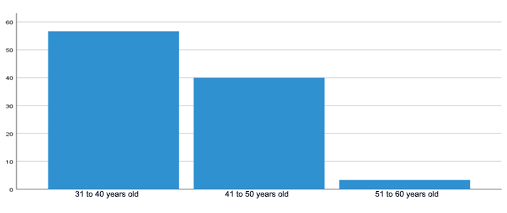
Source: Data taken from employee interview database
It is observed that according to age, the predominance was the range between 31 and 40 years old with 17 (56.7%), followed by the age range between 41 and 50 years old (40%). About age, most of the outpatient medical personnel of the Social Security medical clinic had an age range of 31 to 40 years, this coincides with the study by López Castro (2022), in which he reports that 33.7% of emergency medical personnel are between the ages of 31 and 40 years. It also coincides with the study by María Lucin, Kenny Escobar, and Cristian Arias (2020), where it is reported that 46.9% of medical personnel are between the ages of 30 and 39 years.
Graph 2
Sex of the medical staff of the Amistad Japón-Nicaragua Pension Medical Clinic. Granada.
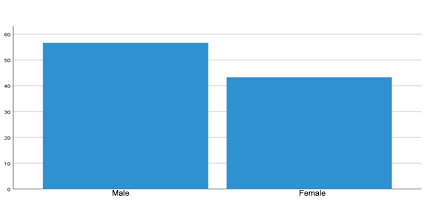
Source: Data taken from a database of interviews conducted with workers.
In the graph, 17 (56.7%) belonged to the male gender, followed by 13 (43.3%) to the female gender. About sex. The sex that predominated in the outpatient clinic of the social security clinic was male, which differs from the study by María Luncin, Kenny Escobar, and Cristian Arias (2020), where it is reported that 62.6% of the female sex also coincides with the study by Jhaira Sánchez (2022), where it is reported that the predominance of sex in 54% is male.
Graph 3
The seniority of the outpatient medical staff of the Amistad Japón-Nicaragua Medical Clinic, Granada.
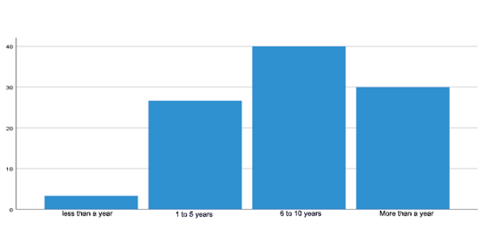
Source: Data taken from a database of interviews conducted with workers.
It is observed that 12 (40%) have been with the company for between 6 and 10 years, as well as 9 (30%). They are more than 10 years old. Also, 8 (26.7%) have a work seniority of between 1 and 5 years. As for the predominance of medical personnel, it was among the 6 to 10-year age group, which coincides with the study by López Castro (2022), which reports that 38.4% of the personnel are in the 5 to 10-year age group.
Work seniority of 10 years is a factor that influences the appearance of musculoskeletal symptoms, which in turn are associated with the ailments of aging. It is known that the longer the exposure to any ergonomic risk factor, the greater the musculoskeletal damage caused.
Graph 4
Position and working hours of the outpatient medical staff of the Amistad Japòn-Nicaragua Pension Medical Clinic, Granada.
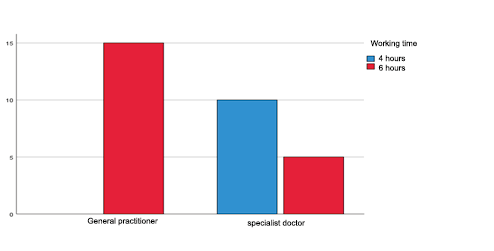
Source: Data taken from a database of interviews conducted with workers.
Corresponding to the job position and working hours, 15 (50%) of the medical personnel are general practitioners who work 8 hours, followed by 10 (33.3%), specialist medical personnel who work 4 hours, and 5 (16.7%) of the specialist medical personnel who work 8 hours. It was observed that general medical personnel are those who have a working schedule of 8 hours a day, which differs from the study by María Luncin, Kenny Escobar, and Cristian Arias (2020), which reports that 46% of the labor personnel work more than 8 hours a day.
OSHA indicates that at least 8 hours a day employees remain in their workplace, exposed to multiple disergonomic risk factors, which in the future can become a disease of the musculoskeletal system.
Graph 5
presence of discomfort in the body region of the outpatient medical staff of the Amistad Medical Clinic, Japón, Nicaragua, Granada.
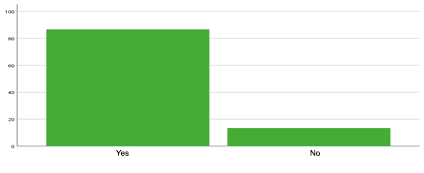
Source: Data taken from a database of interviews conducted with workers.
In this graph, 26 (86.7%) of the medical personnel reported discomfort in some region of the body, and 4 (13.3%), medical personnel reported no discomfort. It was also observed that most of the medical personnel presented some discomfort in some regions of the body. It coincides with the study by López Castro (2022), which reports that 86.5% of the surveyed personnel reported discomfort in some region of the body.
It is noteworthy to mention that almost all workers manifest musculoskeletal pain according to their perception if we take into account that for the development of a musculoskeletal pathology we require the presence of risk (static, forced postures).
Graph 6
Location of pain in medical personnel outpatient clinic of the medical clinic pension Amistad Japón Nicaragua, Granada.

Source: Data taken from a database of interviews conducted with workers.
According to the location of the pain of the personnel, 10 (33.3%) of the medical personnel reported pain located in the right shoulder, followed by 7 (23.3%), reported pain located in the right hand. The region of the body where the greatest discomfort occurs is the shoulder area, which differs from the study by López Castro (2022), which reports that 61.5% of the personnel report that the region of the body where they present discomfort is the lumbar region. It also differs from the study by María Luncin, Kenny Escobar, and Cristian Arias (2020), which reports that 67.8% of the personnel report the region of the body where they present discomfort is the dorsal lumbar region.
Graph 7
Type of discomfort presented by the medical staff of the medical outpatient clinic friendship Japan Nicaragua, Granada.
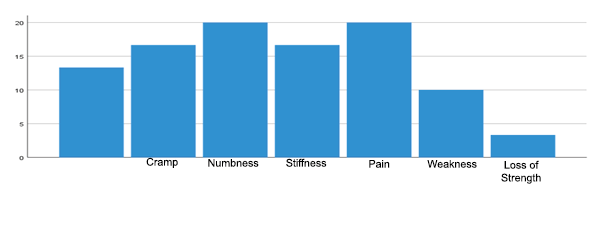
Source: Data taken from a database of interviews conducted with workers.
Several 6 (20%) of the medical personnel reported pain, followed by 6 (20%), of the medical personnel reported numbness, then 5 (16.7%), medical personnel reported cramps and 5 (16.7%) reported stiffness. Regarding the symptom that medical personnel reported the most was pain, this coincides with the study by López Castro (2022), where it is reported that 86.5% of the personnel report pain as the symptom that they report the most.
Graph 8
Exposed musculoskeletal disorders of the outpatient medical staff of the Amistad Japón-Nicaragua Pension Medical Clinic, Granada.
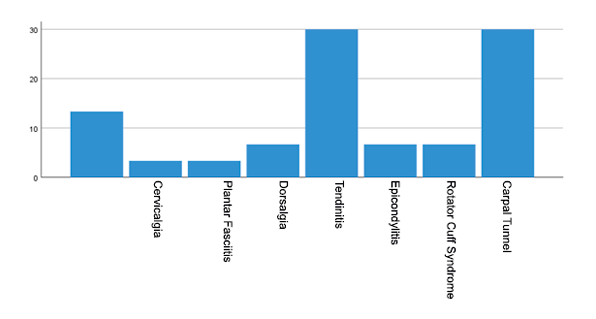
Source: Data taken from a database of interviews conducted with workers.
In Graph 8. A total of 10 (33.3%) of the medical staff had shoulder tendinitis as the main musculoskeletal disorder. Followed by 9 (30%) of medical personnel who present carpal tunnel. Shoulder tendonitis was the main musculoskeletal disorder affecting medical personnel. This differs from the study by Jhaira Sánchez (2022), in which she reports that 48% of the staff had low back pain as the main musculoskeletal disorder. It also differs from the study by María Luncin, Kenny Escobar, and Cristian Arias (2020), which reports that 38.8% of the staff has low back pain as the main musculoskeletal disorder.
Graph 9
Sex and musculoskeletal disorders in the outpatient medical staff of the Amistad Japón Nicaragua medical clinic, Granada.
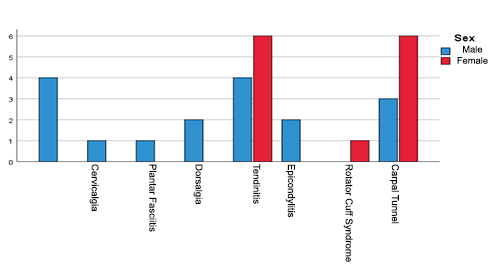
Source: Data taken from a database of interviews conducted with workers.
According to sex and musculoskeletal disorders, 13 (100%) of the female medical personnel have presented a musculoskeletal disorder, and at the same time, 13 (76.4%) have presented a musculoskeletal disorder. It was observed that all female medical personnel have musculoskeletal disorders. This differs from the study by López Castro (2022), in which he reports that the occurrence of musculoskeletal disorders did not differ significantly according to the sex of the personnel
Graph 10
Age and musculoskeletal disorder in the outpatient medical staff of the Amistad Japón Nicaragua medical medical clinic, Granada.
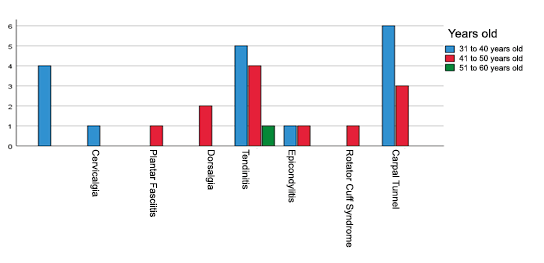
Source: Data taken from a database of interviews conducted with workers.
A total of 17 (56.6%) of the medical personnel with a predominance of the age range of 31 to 40 years have musculoskeletal disorders, followed by 12 (40%) of the medical personnel with an age range of 41 to 50 years who present musculoskeletal disorders (see annex. Table 10). The age range with the highest presence of musculoskeletal disorders is between 31 and 40 years old. This coincides with the study by López Castro (2022), which reports that 91.4% of personnel between 31 and 40 years of age presented musculoskeletal disorders.
Graph 11
Work seniority and musculoskeletal disorders in the outpatient medical staff of the medical clinic pension friendship Japan Nicaragua, Granada.
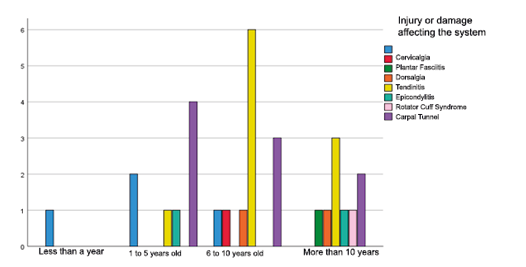
Source: Data taken from a database of interviews conducted with workers.
Regarding seniority and musculoskeletal disorders, 12 (40%) of medical personnel have work seniority in the range between 6 and 10 years, followed by 9 (30%) of medical personnel with seniority of more than 10 years. Regarding work seniority and the presence of musculoskeletal disorders, there was a predominance in the range of work seniority of between 6 and 10 years in the presence of musculoskeletal disorders, which coincides with the study by López Castro (2022), which reports that 93% of the staff has musculoskeletal disorders with work seniority of between 5 and 10 years.
Graph 12
Region of the body where there is discomfort about how long the medical staff of the medical outpatient clinic has had discomfort in the last 12 months, Amistad Japón Nicaragua, Granada.
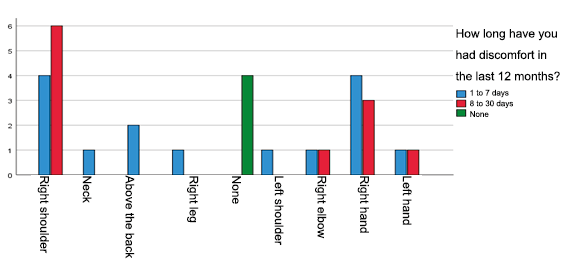
Source: Data taken from the database of the Nordic questionnaire application.
A total of 6 (20.0%) of the medical personnel presented discomfort in the right hand in a period of 8 to 30 days, likewise, 3 (10.0%) presented discomfort in the right hand in a period of 8 to 30 days. It was observed that the region of the body that had predominance was the right shoulder frequently between 8 to 30 days, which does not coincide with the study by López Freddy (2020), which reports discomfort in the neck frequently between 8 and 30 days.
Graph 13
About the region of the body where there is discomfort and how long each episode lasts, the medical staff of the medical outpatient clinic Amistad Japón Nicaragua, Granada.
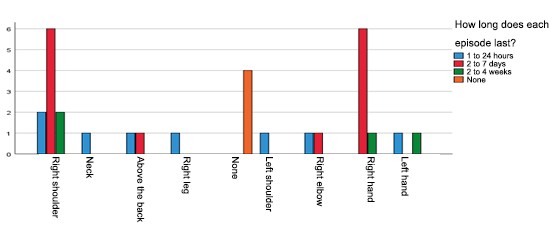
Source: Data taken from the database of the Nordic questionnaire application.
About the region where the greatest discomfort is presented, (20.0%) reported both the right shoulder and the right hand, each with a frequency in the period of 2 to 7 days, followed by 2 (6.7%), right shoulder in the period of 1 to 24 hours. It was observed that the region of the body where they present discomfort and the frequency of the episode had a predominance of both the right shoulder and the right hand with a frequency of 2 to 7 days, which does not coincide with the study by López Freddy (2020) who reports that the lumbar region and frequency of between 8 and 30 days.
Graph 14
About the region of the body where he presents discomfort and how long this discomfort has prevented him from performing his work in the last 12 months to the medical staff of the pension clinic friendship Japan Nicaragua, and Granada.
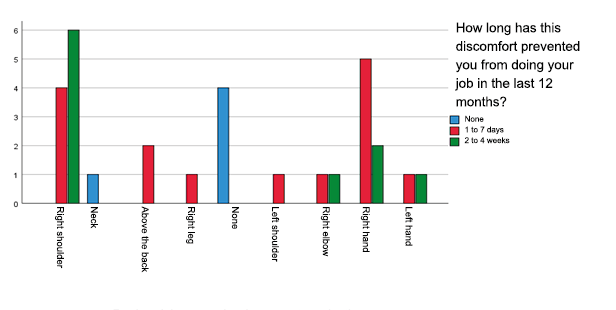
Source: Data taken from the Nordic questionnaire application database
This graph shows the predominance with 6 (20.0%), the right shoulder frequently prevented from working for 2 to 4 weeks, as well as 5 (16.7%), right hand with frequency from 1 to 7 days, as well as with 4 (13.3%), right shoulder with frequency from 1 to 7 days. It was observed that the most frequent discomfort in the body was the right shoulder, frequently impeding work for between 2 to 4 weeks, which coincides with the study by López Freddy (2020), who reports that the shoulder region in its entirety (100%) is located between 1 to 4 weeks.
Graph 15
About the region of the body where you have discomfort and if you have received treatment for the discomfort in the last 12 months, the medical staff of the medical clinic in Amistad Japón Nicaragua, Granada.
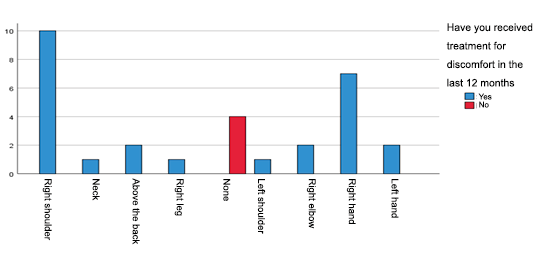
Source: Data taken from the Nordic questionnaire application database
This graph shows the predominance of 10 (33.3%), the right shoulder is reported to have received treatment, likewise 7 (23.3%), and the right hand received treatment. It is evident that the right shoulder is the region of the body with the most cases, but that in its entirety they received treatment, which does not coincide with the study of López Freddy, who reports that the region of the body such as the shoulder, 100% of those located in this area did not receive treatment
Graph 16
About the region of the body where you have discomfort and if you have had discomfort in the last 7 days, the outpatient medical staff of the medical clinic amistad Japón Nicaragua, Granada.
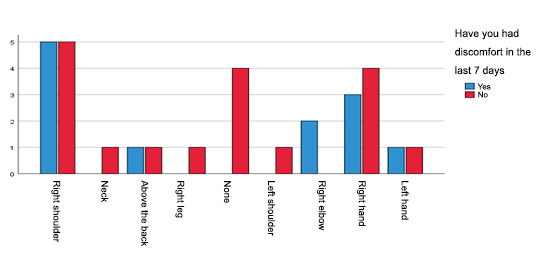
Source: Data taken from the Nordic questionnaire application database
It corresponds to 5 (16.7%), right man who have had no discomfort in the last 7 days and 5 (16.7%), right man who has not had discomfort in the last 7 days, followed by 4 (13.3%), right hand who has not had discomfort in the last 7 days. It is observed that about the region of the body where he presents discomfort and that if he has had discomfort in the last 7 days, the right shoulder predominated for both. This does not coincide with López Freddy’s study, which does not report cases of shoulder pain and the presence of discomfort in the last 7 days.
Graph 17
Relationship between the region of the body where the patient has discomfort and what he attributes this discomfort to.
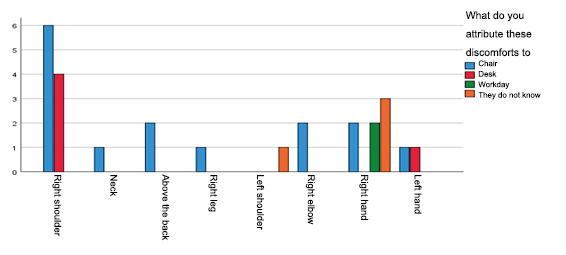
Source: Data taken from the Nordic questionnaire application database
Graph N°17. It corresponds to 6 (23.1%), the right shoulder as the region of the body where the greatest discomfort is presented and which is mainly attributed to the chair, followed by 4 (15.4%), a right shoulder that attribute discomfort because of the desk.
The right shoulder is the region of the body with the greatest predominance in medical personnel and among the causes to which they attribute these discomforts, the greatest factor referred was the chair, followed by the desk. This does not coincide with the study by López Freddy (2020), who states that in the case of shoulder discomfort is attributed to poor posture
CONCLUSIONS.
It is important to remember that the descriptive analysis carried out leads to finding a trend in pain in workers; that is, the way it is perceived during the performance of the work, showing that at the level of the right shoulder, 16.7% of the staff visualize it and associate it with the desk. When assessing the situation related to discomfort in the last seven days, the position of the respondents is 40.0% of the personnel who have presented pain. In addition, they consider that the discomfort presented is due to the chair, therefore, it can be inferred that the worker, by not having adequate chairs during the performance of the work, adds problems in their body that lead them to have disorders that can be considered within the field of occupational diseases. Similarly, it can be observed that those aspects related to diseases, it could be seen that their responses presented a greater tendency in shoulder tendinitis in 33.3%, continuing with 30.3% in carpal tunnel syndrome; in addition, 6.7% is found in dorsalgia. In this same direction, it can be indicated that, when comparing the results expressed in the present research, with the study aimed at evaluating musculoskeletal disorders of medical personnel; In their analysis, it is evident that health personnel have musculoskeletal disorders predominantly in the upper limb followed by the lumbar region. The male sex and age group between 31 and 40 years reported 56.6% in both cases of musculoskeletal disorders, respectively. Likewise, it is evident in terms of the time of the discomfort that has prevented him from performing his work on the right shoulder type for a period of between two to four weeks. The attention of workers where they consider their working conditions optimal makes it possible to reduce the effects or injuries in individuals that affect their health, improving the quality of life of the personnel, their absences, and workload to other colleagues, it is important to look for new alternatives that allow managing the respective structural changes, to reduce in the work areas the reduction of risks that can lead to health disorders and to obtain the well-being of the staff.
works Cited
Arbeláez, G. Velásquez, Tamayo, Principal musculoskeletal pathologies related to ergonomic risk derived from administrative work activities. Revista CES Salud Pública, ISSN-e 2145-9932, Vol. 2, No. 2, 2011, pp. 196-203.
Ballena A, Ramos P, Suarez C. Musculoskeletal disorders in health workers of a private clinic in Lima. Peruvian Journal of Health Care & Global Health. [online]. 2021 [accessed on 23 June 2022]; 5(2):38-43. Available in: http://revista.uch.edu.pe/index.php/hgh/article/view/125/96
Carranza, Alessandra & Sánchez, Katty (2022). Risk factors and the presence of musculoskeletal disorders in caregivers of patients with disabilities in a residential care center, San Miguel, 2022. [Thesis to obtain the professional title of Bachelor of Nursing. Cesar Vallejo University, Faculty of Health Sciences. Lima-Peru]. Retrieved from: https://hdl.handle.net/20.500.12692/97466
Castilla & León, Secretary of Occupational Health. Manual of musculoskeletal disorders.2008.https://castillayleon.ccoo.es/945c897036b42bdf269 409d45787c2aa000054.pdf.
Escobar Segovia, Kenny & Ulloa, Christian & Salazar, Gabriela. (2020). Osteomuscular Prevalences in Health Personnel of the External Consultation Area of a Service Provider of the Ecuadorian Institute of Social Security (EISS). https://www.researchgate.net/publication/342902473.
Guerrero Silva, C. F. (2019). Ergonomic risk assessment applying the Reba method to the administrative workers of the Municipal Public Company Property Registry of Guayaquil. [Degree thesis – industrial engineering, University of Guayaquil. Faculty of Industrial Engineering]. Retrieved from: http://repositorio.ug.edu.ec/handle/redug/42144
Nicaraguan Institute of Social Security (2021). Statistical Yearbook 2020.
Retrieved from: https://inss-princ.inss.gob.ni/images/anuarios/Anuario_Estadstico_2020.pdf.
GENERAL LAW ON OCCUPATIONAL HEALTH AND SAFETY, LAW NO. 618 (2007). http://legislacion.asamblea.gob.ni/Normaweb.nsf/($All)/16624DBD812ACC1 B06257347006A6C8C? OpenDocument.
López Castro, Freddy (2022). musculoskeletal disorders in emergency service health workers. El Carmen-Huancayo Hospital, 2022. [Thesis for medical surgeon degree. Universidad Peruana Los Andes]. https://hdl.handle.net/20.500.12848/4610.
Madrid Deras, Kamila Yhizeel (2020) Evaluation of disergonomic risks and their musculoskeletal effects in administrative collaborators of a manufacturing company, Choloma, Honduras. June to December 2019. Master’s thesis, CIES UNAN Managua. http://repositorio.unan.edu.ni/id/eprint/13186.
Ministry of Labor. Compilation of laws and regulations on occupational health and safety . Managua, Nicaragua, March 2008.
https://oiss.org/wpcontent/uploads/2018/11/1Compendio_normativo_Hig_Seg_Nicaragua.pdf
Molina Loza, Nelly de los Ángeles (2022) Ergonomic factors to which the staff of the Aquatic Resources Research Center (CIRA) UNAN-Managua is exposed and their clinical manifestations in the second semester of 2021. ( Master’s Thesis in Occupational Health). Center for Research and Studies for Health (CIES), Autonomous University of Nicaragua (UNAN), Managua. https://repositorio.unan.edu.ni/17975/1/t1192.pdf
Morales J; Carcausto W. Musculoskeletal disorders in health workers of the first level of care in the Callao Region. Rev Asoc Esp Med Trab March 2019 [online]. 2019 [accessed June 22, 2022]; 28(1):1-82 Available at: https://scielo.isciii.es/pdf/medtra/v28n1/1132-6255-medtra-28-01-38.pd.
International Labor Organization. ILO urges global action to combat occupational diseases [Internet]. 2013 April. [cited 22 October 2021]. 58 Available at: http://www.ilo.org/global/about-theilo/newsroom/news/WCMS_211645/lang--es/index.htm.
World Health Organization. (2021). Musculoskeletal disorders. Retrieved from: https://www.who.int/es/news-room/fact-sheets/detail/musculoskeletal-conditions
Pan American Health Organization, World Health Organization. EP No 1 technical sheet, March 2013. Prevention of occupational diseases: World Day for Safety and Health at Work 2013 [internet]. [cited 2017 Nov 13]. Retrieved from http://www.paho.org/hq/index.php?option=com_docman&task=doc_view&gi d=21%20040&Itemid=270&lang=e..
Prieto, A., Higuera, C., Gómez, J. & Díaz, J. (2022). Effects on the Health of the Security Guard Associated with Physical, Psychosocial and Ergonomic Hazards. (Monograph). Corporación Universitaria Minuto de Dios, Bogotá – Colombia. Retrieved from: https://hdl.handle.net/10656/14749
Rojas M, Gimeno D, Vargas-Prada S, Benavides FG. Musculoskeletal pain in workers in Central America: results of the First Central American Survey of Working Conditions and Health. Rev Panam Salud Publica. 2015; 38(2):120–8. https://www.scielosp.org/article/rpsp/2015.v38n2/120-128/
Santamaría R. “Ergonomic risks and musculoskeletal wear disorders in nurses at the Arzobispo Loayza National Hospital, 2018” [Degree thesis]. Lima: UCV. Faculty of Medical Sciences; Available at: https://repositorio.ucv.edu.pe/bitstream/handle/20.500.12692/17502/SANTAMARIA _YR.pdf?sequence=1&isAllowed=y.
Sunsin González, Darling (2022) Ergonomic risks of the workers of the company Geosesa & Infinite Outsourcing Services. S.A, Managua, Nicaragua, period August - October 2022. [Master’s Thesis in Occupational Health 2020-2022 Managua. CIES/UNAN- Managua]. Retrieved from https://repositorio.unan.edu.ni/19180/1/t1200.pdf.